wlanWaveformGenerator
Generate WLAN waveform
Syntax
Description
waveform = wlanWaveformGenerator(bits,cfg)bits, the specified information
bits, and cfg, the physical layer (PHY) format
configuration. For more information, see IEEE 802.11 PPDU Format.
waveform = wlanWaveformGenerator(bits,cfg,Name,Value)
wlanWaveformGenerator opens the WLAN Waveform
Generator app.
Examples
Create a configuration object for a WLAN EHT TB transmission.
cfgEHTTB = wlanEHTTBConfig;
Get the PSDU length, in bytes, from the configuration object by using the psduLength object function.
length = psduLength(cfgEHTTB);
Generate a PSDU of the relevant length, converting bytes to bits by multiplying by eight.
psdu = randi([0 1],8*length,1);
Generate a time-domain waveform for the bits and configuration, specifying an oversampling factor of 3. Plot the waveform.
waveform = wlanWaveformGenerator(psdu,cfgEHTTB,OversamplingFactor=3); plot(abs(waveform)); title("EHT TB Waveform"); xlabel("Time (Nanoseconds)"); ylabel("Amplitude");
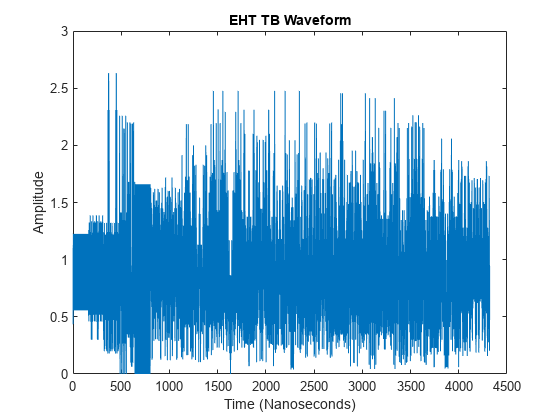
Create a configuration object for a non-OFDMA EHT MU packet. Set the channel bandwidth to 160 MHz, the number of users to two, and the number of transmit antennas to two.
cfgEHTMU = wlanEHTMUConfig("CBW160",NumUsers=2,NumTransmitAntennas=2);Obtain the PSDU length for both users, in bytes, from the configuration object by using the psduLength object function.
length = psduLength(cfgEHTMU);
Create a two-element cell array containing random PSDUs of the relevant length.
psdu = {randi([0 1],8*length(1),1);randi([0 1],8*length(2),1)};Generate and plot the waveform.
waveform = wlanWaveformGenerator(psdu,cfgEHTMU); figure; plot(abs(waveform)); title('EHT MU Waveform'); xlabel('Time (nanoseconds)'); ylabel('Amplitude'); legend('First transmit antenna','Second transmit antenna')

Configure and generate a WLAN waveform containing an HE TB uplink packet.
Create a configuration object for a WLAN HE TB uplink transmission.
cfgHETB = wlanHETBConfig;
Obtain the PSDU length, in bytes, from the configuration object by using the getPSDULength object function.
psduLength = getPSDULength(cfgHETB);
Generate a PSDU of the relevant length.
psdu = randi([0 1],8*psduLength,1);
Generate and plot the waveform.
waveform = wlanWaveformGenerator(psdu,cfgHETB); figure; plot(abs(waveform)); title('HE TB Waveform'); xlabel('Time (nanoseconds)'); ylabel('Amplitude');

Generate a time-domain signal for an 802.11ac VHT transmission with one packet.
Create a VHT configuration object. Assign two transmit antennas and two spatial streams, and disable space-time block coding (STBC). Set the modulation and coding scheme to 1, which assigns QPSK modulation and a 1/2 rate coding scheme per the 802.11 standard. Set the number of bytes in the A-MPDU pre-EOF padding, APEPLength, to 1024.
cfg = wlanVHTConfig('NumTransmitAntennas',2,'NumSpaceTimeStreams',2,'STBC',0,'MCS',1,'APEPLength',1024);
Generate the transmit waveform.
bits = [1;0;0;1]; txWaveform = wlanWaveformGenerator(bits,cfg);
HE MU-MIMO Configuration With SIGB Compression
Generate a full bandwidth HE MU-MIMO configuration at 20 MHz bandwidth with SIGB compression. All three users are on a single content channel, which includes only the user field bits.
cfgHE = wlanHEMUConfig(194); cfgHE.NumTransmitAntennas = 3;
Create PSDU data for all users.
psdu = cell(1,numel(cfgHE.User)); psduLength = getPSDULength(cfgHE); for j = 1:numel(cfgHE.User) psdu = randi([0 1],psduLength(j)*8,1,'int8'); end
Generate and plot the waveform.
y = wlanWaveformGenerator(psdu,cfgHE); plot(abs(y))
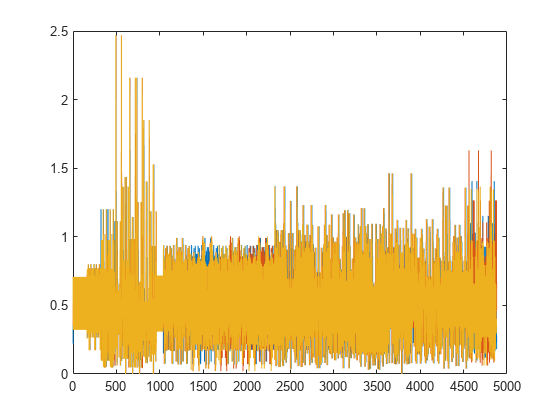
Generate a full bandwidth HE MU-MIMO waveform at 80 MHz bandwidth with SIGB compression. HE-SIG-B content channel 1 has four users. HE-SIG-B content channel 2 has three users.
cfgHE = wlanHEMUConfig(214); cfgHE.NumTransmitAntennas = 7;
Create PSDU data for all users.
psdu = cell(1,numel(cfgHE.User)); psduLength = getPSDULength(cfgHE); for j = 1:numel(cfgHE.User) psdu = randi([0 1],psduLength(j)*8,1,'int8'); end
Generate and plot the waveform.
y = wlanWaveformGenerator(psdu,cfgHE); plot(abs(y));

HE MU-MIMO Configuration Without SIGB Compression
Generate a full bandwidth HE MU-MIMO configuration at 20 MHz bandwidth without SIGB compression. All three users are on a single content channel, which includes both common and user field bits.
cfgHE = wlanHEMUConfig(194); cfgHE.SIGBCompression = false; cfgHE.NumTransmitAntennas = 3;
Create PSDU data for all users.
psdu = cell(1,numel(cfgHE.User)); psduLength = getPSDULength(cfgHE); for j = 1:numel(cfgHE.User) psdu = randi([0 1],psduLength(j)*8,1,'int8'); end
Generate and plot the waveform.
y = wlanWaveformGenerator(psdu,cfgHE); plot(abs(y))
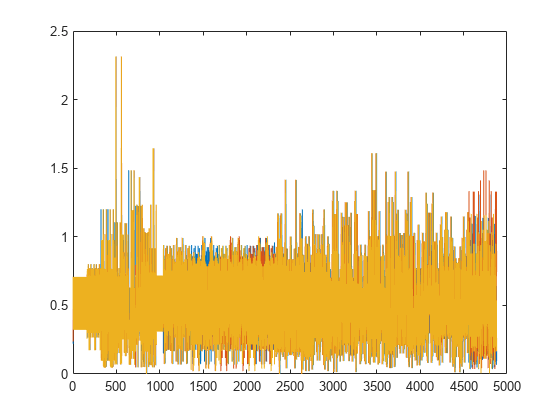
Generate an 80 MHz HE MU waveform for six users without SIGB compression. HE-SIG-B content channel 1 has four users. HE-SIG-B content channel 2 has two users.
cfgHE = wlanHEMUConfig([202 114 192 193]); cfgHE.NumTransmitAntennas = 6; for i = 1:numel(cfgHE.RU) cfgHE.RU{i}.SpatialMapping = 'Fourier'; end
Create PSDU data for all users.
psdu = cell(1,numel(cfgHE.User)); psduLength = getPSDULength(cfgHE); for j = 1:numel(cfgHE.User) psdu = randi([0 1],psduLength(j)*8,1,'int8'); end
Generate and plot the waveform.
y = wlanWaveformGenerator(psdu,cfgHE); plot(abs(y));
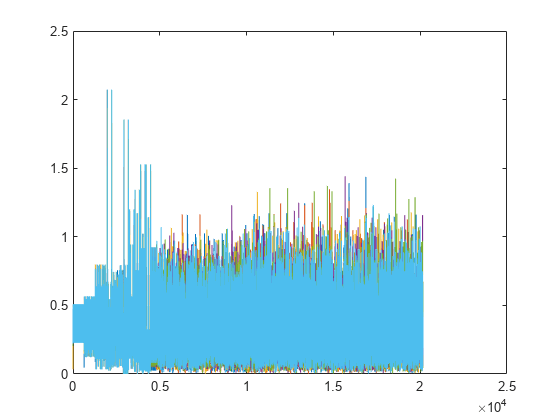
Generate a full bandwidth HE MU-MIMO waveform at 80 MHz bandwidth without SIGB compression. HE-SIG-B content channel 1 has seven users. HE-SIG-B content channel 2 has zero users.
cfgHE = wlanHEMUConfig([214 115 115 115]); cfgHE.NumTransmitAntennas = 7;
Create PSDU data for all users.
psdu = cell(1,numel(cfgHE.User)); psduLength = getPSDULength(cfgHE); for j = 1:numel(cfgHE.User) psdu = randi([0 1],psduLength(j)*8,1,'int8'); end
Generate and plot the waveform.
y = wlanWaveformGenerator(psdu,cfgHE); plot(abs(y))
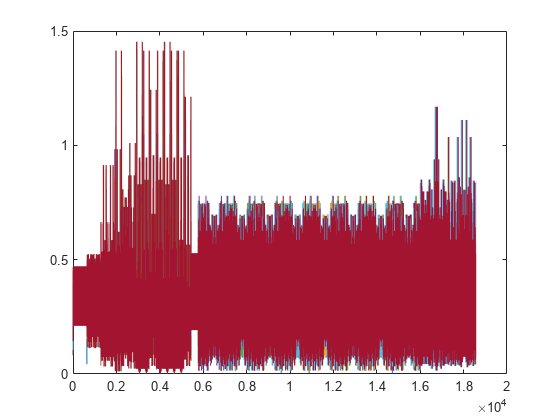
Generate a time-domain signal for an 802.11ac VHT transmission with five packets and a 30-microsecond idle period between packets. Use a random scrambler initial state for each packet.
Create a VHT configuration object and confirm the channel bandwidth for scaling the x-axis of the plot.
cfg = wlanVHTConfig; disp(cfg.ChannelBandwidth)
CBW80
Generate and plot the waveform. Display the time in microseconds on the x-axis.
numPkts = 5; bits = [1;0;0;1]; scramInit = randi([1 127],numPkts,1); txWaveform = wlanWaveformGenerator(bits,cfg,'NumPackets',numPkts,'IdleTime',30e-6,'ScramblerInitialization',scramInit); time = [0:length(txWaveform)-1]/80e-6; plot(time,abs(txWaveform)); title('Five Packets Separated by 30-Microsecond Idle Periods'); xlabel ('Time (microseconds)'); ylabel('Amplitude');
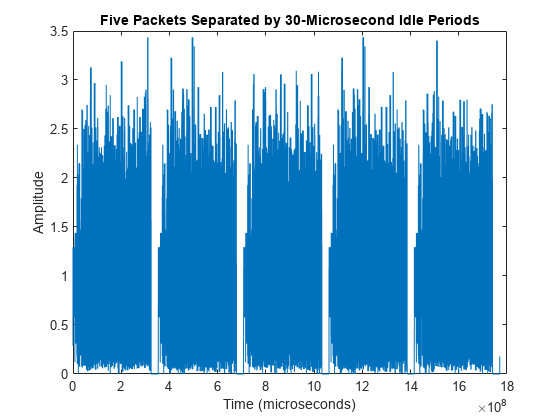
Input Arguments
Information bits, including any MAC padding representing multiple concatenated PSDUs, specified as one of these values.
0or1. The specified bit applies to all users.A binary-valued vector. The specified bits apply to all users.
A one-by-one cell array containing a binary-valued scalar or vector. The specified bits apply to all users.
A vector cell array of binary-valued scalars or vectors. The kth element of the cell array applies to the kth user. The length of the cell array must be equal to the number of users. For each user, if the number of bits required across all packets of the generation exceeds the length of the vector provided, the function loops the applied bit vector. Looping the bits enables you to define a short pattern, for example,
[1; 0; 0; 1], that the function repeatedly uses as the input to the PSDU coding across packets and users. In each packet generation, for the kth user, the kth element of thePSDULengthproperty of thecfginput indicates the number of data bytes in its stream. To compute the number of bits, multiplyPSDULengthby 8.
Internally, the function loops this input to generate the specified number
of packets. The PSDULength property of the
cfg input specifies the number of data bits taken
from the bit stream for each transmission packet generated. The
'NumPackets' input specifies the number of packets
to generate.
Example: [1 1 0 1 0 1 1]
Data Types: double | int8
Packet format configuration, specified as one of these objects: wlanEHTMUConfig, wlanEHTTBConfig, wlanHEMUConfig, wlanHESUConfig, wlanHETBConfig,
wlanWURConfig,
wlanDMGConfig, wlanS1GConfig, wlanVHTConfig, wlanHTConfig, or wlanNonHTConfig. The type of
object you specify determines the IEEE®
802.11™ format of the generated waveform.
The properties of the packet format configuration object determine the data rate and PSDU length of generated PPDUs.
Name-Value Arguments
Specify optional pairs of arguments as
Name1=Value1,...,NameN=ValueN, where Name is
the argument name and Value is the corresponding value.
Name-value arguments must appear after other arguments, but the order of the
pairs does not matter.
Before R2021a, use commas to separate each name and value, and enclose
Name in quotes.
Example: 'NumPackets',21,'ScramblerInitialization',[52,17]
Number of packets to generate in a single function call, specified as a positive integer.
Data Types: double
Idle time, in seconds, added after each packet, specified as a nonnegative scalar. Except for the default value, this input must be greater than or equal to:
1e-6for DMG format2e-6for all other formats
Example: 2e-5
Data Types: double
Oversampling factor, specified as a scalar greater than or equal to 1. The oversampled cyclic prefix length must be an integer number of samples. For more information about oversampling, see FFT-Based Oversampling.
Dependencies
This argument applies only for EHT, HE, WUR, VHT, HT, S1G, and non-HT OFDM formats.
Data Types: double | single | int8 | int16 | int32 | int64 | uint8 | uint16 | uint32 | uint64
Initial scrambler state or initial pseudorandom scrambler sequence for each generated packet and each user, specified as one of these values.
An integer in the interval [1, 127] — This input represents the initial scrambler state for all packets and users in HE, S1G, VHT, and HT waveforms, and non-HT OFDM waveforms with bandwidth signaling disabled. For multi-user and multipacket waveforms, the function uses the value you specify for all packets and users. The default value,
93, is the example state in Section I.1.5.2 of [1]. For more information, see Scrambler Initialization.An integer in the interval [1, 2047]. This input represents the initial scrambler state for all packets and users in EHT waveforms. For multi-user and multipacket waveforms, the function uses the value you specify for all packets and users.
An integer in the interval [min, max] — This input represents the initial pseudorandom scrambler sequence of a non-HT transmission with bandwidth signaling enabled, described in Table 17-7 of [1]. If you do not specify this input, the function uses the NB most significant bits of the default value,
93. The values of min, max, and NB depend on the values of theBandwidthOperationandChannelBandwidthproperties of thecfginput according to this table.Value of cfg.BandwidthOperationValue of cfg.ChannelBandwidthValue of min Value of max Value of NB 'Absent''CBW20'or'CBW320'1 31 5 'CBW5','CBW10','CBW40','CBW80', or'CBW160'0 31 'Static''CBW20'or'CBW320'1 15 4 'CBW5','CBW10','CBW40','CBW80', or'CBW160'0 15 'Dynamic'All bandwidths 0 15 4 A matrix of integers in the interval [1, 127], of size NP-by-NUsers — Each element represents an initial state of the scrambler for each packet and for each user in VHT, S1G, and HE multi-user (MU) waveforms comprising multiple packets. Each column specifies the initial states for a single user. You can specify up to eight columns for HE MU waveforms, or up to four columns for VHT and S1G. If you specify a single column, the function uses the same initial states for all users. Each row represents the initial state of each packet to generate. A matrix with multiple rows enables you to use a different initial state per packet, where the first row contains the initial state of the first packet. If the number of packets to generate exceeds the number of rows of the matrix provided, the function loops the rows internally.
NP is the number of packets.
NUsers is the number of users.
A matrix of integers in the interval [1, 2047], of size NP-by-NUsers — Each element represents an initial state of the scrambler for each packet and for each user in EHT multi-user (MU) waveforms comprising multiple packets. Each column specifies the initial states for a single user. You can specify up to 144 columns for EHT MU waveforms. If you specify a single column, the function uses the same initial states for all users. Each row represents the initial state of each packet to generate. A matrix with multiple rows enables you to use a different initial state per packet, where the first row contains the initial state of the first packet. If the number of packets to generate exceeds the number of rows of the matrix provided, the function loops the rows internally.
NP is the number of packets.
NUsers is the number of users.
For DMG transmissions, specifying this argument overrides the value of
the ScramblerInitialization property of the wlanDMGConfig configuration
object.
Example: [3 56 120]
Dependencies
This argument is not valid for WUR formats and DSSS non-HT formats.
Data Types: double | int8
Duration, in seconds, of the window transition applied to each OFDM
symbol, specified as a nonnegative scalar. The function does not apply
windowing if you specify this input as 0. This table
shows the default and maximum values permitted for each format, the type
of guard interval, and the channel bandwidth.
| Format | Bandwidth | Permitted
WindowTransitionTime
(seconds) | |||||
|---|---|---|---|---|---|---|---|
| Default Value | Maximum Value | Maximum Permitted Value Based on Guard Interval Duration | |||||
| 3.2 µs | 1.6 µs | 0.8 µs (Long) | 0.4 µs (Short) | ||||
| EHT MU and EHT TB | 20, 40, 80, 160, or 320 MHz |
| Not applicable |
|
|
| Not applicable |
| HE SU, HE MU, and HE TB | 20, 40, 80, or 160 MHz |
| Not applicable |
|
|
| Not applicable |
| VHT | 20, 40, 80, or 160 MHz |
| Not applicable | Not applicable | Not applicable |
|
|
| HT-mixed | 20 or 40 MHz |
| Not applicable | Not applicable | Not applicable |
|
|
| non-HT | 20, 40, 80, or 160 MHz |
| Not applicable | Not applicable | Not applicable |
| Not applicable |
10 MHz | 1.0e-07 | Not applicable | Not applicable | Not applicable |
| Not applicable | |
5 MHz | 1.0e-07 | Not applicable | Not applicable | Not applicable |
| Not applicable | |
| WUR | 20, 40, 80 MHz |
| Not applicable | Not applicable | Not applicable | Not applicable | Not applicable |
| DMG | 2640 MHz |
(=
|
(=
| Not applicable | Not applicable | Not applicable | Not applicable |
| S1G | 1, 2, 4, 8, or 16 MHz |
| Not applicable | Not applicable | Not applicable |
|
|
Data Types: double
Output Arguments
Time-domain waveform, returned as an
NS-by-NT
matrix. NS is the number of
time-domain samples and NT is the
number of transmit antennas. waveform contains one or
more packets of the same PPDU format. Each packet can contain different
information bits. Enable waveform packet windowing by setting the
WindowTransitionTime input to a positive value.
Windowing is enabled by default.
For more information, see Waveform Sampling Rate, OFDM Symbol Windowing, and Waveform Looping.
Data Types: double
Complex Number Support: Yes
More About
Supported IEEE 802.11 PPDU formats defined for transmission include EHT, HE, WUR, VHT, HT, non-HT, S1G, and DMG. For all formats, the PPDU field structure includes preamble and data portions. For a detailed description of the packet structures for the various formats supported, see WLAN PPDU Structure.
At the output of this function, the generated waveform has a sampling rate equal to the channel bandwidth.
For all EHT, HE, VHT, HT, and non-HT format OFDM modulation, the channel bandwidth is
configured via the ChannelBandwidth property of the format
configuration object.
For the DMG format modulation schemes, the channel bandwidth is always 2640 MHz and the channel spacing is always 2160 MHz, as specified in sections 20.3.4 and E.1 of [1], respectively.
For the non-HT format DSSS modulation scheme, the chipping rate is always 11 MHz, as specified in Section 16.1.1 of [1].
This table indicates the waveform sampling rates associated with standard channel spacing for each configuration format prior to filtering.
Configuration Object | Modulation Type |
| Channel Spacing (MHz) | Sampling Rate (MHz) (FS, FC) |
|---|---|---|---|---|
| OFDMA |
| 20 | FS = 20 |
| 40 | FS = 40 | ||
| 80 | FS = 80 | ||
| 160 | FS = 160 | ||
| 320 | FS = 320 | ||
| OFDMA | 'CBW20' | 20 | FS = 20 |
'CBW40' | 40 | FS = 40 | ||
'CBW80' | 80 | FS = 80 | ||
'CBW160' | 160 | FS = 160 | ||
| OFDM |
| 20 | FS = 20 |
| 40 | FS = 40 | ||
| 80 | FS = 80 | ||
| 160 | FS = 160 | ||
| OFDM |
| 20 | FS = 20 |
| 40 | FS = 40 | ||
| DSSS/CCK | Not applicable | 11 | FC = 11 |
OFDM |
| 5 | FS = 5 | |
| 10 | FS = 10 | ||
| 20 | FS = 20 | ||
'CBW40' | 40 | FS = 40 | ||
'CBW80' | 80 | FS = 80 | ||
'CBW160' | 160 | FS = 160 | ||
'CBW320' | 320 | FS = 320 | ||
wlanWURConfig | OFDM | 'CBW20' | 20 | FS = 20 |
'CBW40' | 40 | FS = 40 | ||
'CBW80' | 80 | FS = 80 | ||
| Control PHY | For DMG, the channel bandwidth is fixed at 2640 MHz. | 2160 | FC = ⅔ FS = 1760 |
SC | ||||
OFDM | FS = 2640 | |||
| OFDM |
| 1 | FS = 1 |
| 2 | FS = 2 | ||
| 4 | FS = 4 | ||
| 8 | FS = 8 | ||
| 16 | FS = 16 | ||
FS is the OFDM sampling rate. FC is the chip rate for single-carrier, control PHY, DSSS, and CCK modulations. | ||||
OFDM naturally lends itself to processing with Fourier transforms. A negative
side effect of using an IFFT to process OFDM symbols is the resulting symbol-edge
discontinuities. These discontinuities cause out-of-band emissions in the transition
region between consecutive OFDM symbols. To smooth the discontinuity between symbols
and reduce the intersymbol out-of-band emissions, you can use the
wlanWaveformGenerator function to apply OFDM symbol
windowing. To apply windowing, set the WindowTransitionTime
input to a positive value.
When windowing is applied, the function adds transition regions to the leading and trailing
edge of the OFDM symbol. Windowing extends the length of the OFDM symbol by
WindowTransitionTime
(TTR).
The extended waveform is windowed by pointwise multiplication in the time domain, using this windowing function specified in section 17.3.2.5 of [1]:
The windowing function applies over the leading and trailing portion of the OFDM symbol:
–TTR/2 to TTR/2
–T – TTR/2 to T + TTR/2
After windowing is applied to each symbol, pointwise addition is used to combine the overlapped regions between consecutive OFDM symbols. Specifically, the trailing shoulder samples at the end of OFDM symbol 1 (T – TTR/2 to T + TTR/2) are added to the leading shoulder samples at the beginning of OFDM symbol 2 (–TTR/2 to TTR/2).
Smoothing the overlap between consecutive OFDM symbols in this manner reduces the out-of-band emissions. The function applies OFDM symbol windowing between:
Each OFDM symbol within a packet
Consecutive packets within the waveform, considering the idle time
IdleTimebetween packets specified by the'IdleTime'inputThe last and the first packet of the generated waveform
Windowing DMG Format Packets
For the DMG format, windowing applies only to packets transmitted using the OFDM PHY and is applied only to the OFDM modulated symbols. For OFDM PHY, only the header and data symbols are OFDM-modulated. The preamble (STF and CEF) and the training fields are single carrier modulated and are not windowed. Similar to the out-of-band emissions experienced by consecutive OFDM symbols, as shown here, the CEF and the first training subfield are subject to a nominal amount of out-of-band emissions from the adjacent windowed OFDM symbol.
For more information on how the function handles windowing for the consecutive packet idle time and for the last waveform packet, see Waveform Looping.
To produce a continuous input stream, you can have your code loop on a waveform from the last packet back to the first packet.
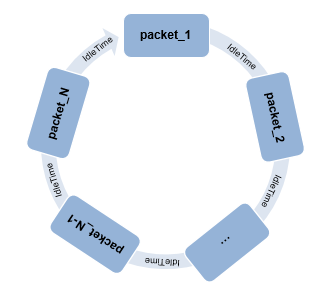
Applying windowing to the last and first OFDM symbols of the
generated waveform smooths the transition between the last and first packet of the
waveform. When the 'WindowTransitionTime' input is positive,
the wlanWaveformGenerator function applies OFDM symbol windowing.
When looping a waveform, the last symbol of packet_N is followed by the first OFDM symbol of packet_1. If the waveform has only one packet, the waveform loops from the last OFDM symbol of the packet to the first OFDM symbol of the same packet.
When windowing is applied to the last OFDM symbol of a packet and the first OFDM of the next
packet, the idle time between the packets factors into the windowing applied.
Specify the idle time by using the 'IdleTime' input to the
wlanWaveformGenerator function.
If
'IdleTime'is0, the function applies windowing as it would be for consecutive OFDM symbols within a packet.Otherwise, the extended windowed portion of the first OFDM symbol in packet_1 (from –TTR/2 to 0–TS), is included at the end of the waveform. This extended windowed portion is applied for looping when computing the windowing between the last OFDM symbol of packet_N and the first OFDM symbol of packet_1. TS is the sample time.
Looping DMG Waveforms
DMG waveforms have these three looping scenarios.
The looping behavior for a waveform composed of DMG OFDM-PHY packets with no training subfields is similar to the general case outlined in Waveform Looping, but the first symbol of the waveform (and each packet) is not windowed.
If
'IdleTime'is0for the waveform, the windowed portion (from T to T + TTR/2) of the last data symbol is added to the start of the STF field.Otherwise, the idle time is appended at the end of the windowed portion (after T + TTR/2) of the last OFDM symbol.
When a waveform composed of DMG OFDM PHY packets includes training subfields, no windowing is applied to the single-carrier modulated symbols the end of the waveform. The last sample of the last training subfield is followed by the first STF sample of the first packet in the waveform.
If
'IdleTime'is0for the waveform, there is no overlap.Otherwise, the value of
'IdleTime'specifies the delay between the last sample of packet_N and the first sample of in packet_1.
When a waveform is composed of DMG-SC or DMG-Control PHY packets, the end of the waveform is single carrier modulated, so no windowing is applied to the last waveform symbol. The last sample of the last training subfield is followed by the first STF sample of the first packet in the waveform.
If
'IdleTime'is0for the waveform, there is no overlap.Otherwise, the value of
'IdleTime'specifies the delay between the last sample of packet_N and the first sample of in packet_1.
Note
The same looping behavior applies for a waveform composed of DMG OFDM-PHY packets with training subfields, DMG-SC PHY packets, or DMG-Control PHY packets.
An oversampled signal is a signal sampled at a frequency that is higher than the Nyquist rate. WLAN signals maximize occupied bandwidth by using small guardbands, which can pose problems for anti-imaging and anti-aliasing filters. Oversampling increases the guardband width relative to the total signal bandwidth, which increases the number of samples in the signal.
This function performs oversampling by using a larger IFFT and zero pad when generating an OFDM waveform. This diagram shows the oversampling process for an OFDM waveform with NFFT subcarriers made up of Ng guardband subcarriers on either side of Nst occupied bandwidth subcarriers.

The scrambler initialization used on the transmission data follows the process described in IEEE Std 802.11-2012, Section 18.3.5.5 and IEEE Std 802.11ad™-2012, Section 21.3.9. The header and data fields that follow the scrambler initialization field (including data padding bits) are scrambled by XORing each bit with a length-127 periodic sequence generated by the polynomial S(x) = x7+x4+1. The octets of the PSDU are placed into a bit stream and, within each octet, bit 0 (LSB) is first and bit 7 (MSB) is last. This figure shows the generation of the sequence and the XOR operation.
Conversion from integer to bits uses left-MSB orientation. For example,
initializing the scrambler with decimal 1, the bits map to these
elements.
| Element | X7 | X6 | X5 | X4 | X3 | X2 | X1 |
|---|---|---|---|---|---|---|---|
| Bit Value | 0 | 0 | 0 | 0 | 0 | 0 | 1 |
To generate the bit stream equivalent to a decimal, use the int2bit function.
For example, for decimal
1:
int2bit(1,7)'
ans =
0 0 0 0 0 0 1References
[1] IEEE Std 802.11-2020 (Revision of IEEE Std 802.11-2016). “Part 11: Wireless LAN Medium Access Control (MAC) and Physical Layer (PHY) Specifications.” IEEE Standard for Information Technology — Telecommunications and Information Exchange between Systems — Local and Metropolitan Area Networks — Specific Requirements.
[2] IEEE Std 802.11ax™-2021 (Amendment to IEEE Std 802.11-2020). “Part 11: Wireless LAN Medium Access Control (MAC) and Physical Layer (PHY) Specifications. Amendment 1: Enhancements for High Efficiency WLAN.” IEEE Standard for Information Technology — Telecommunications and Information Exchange between Systems. Local and Metropolitan Area Networks — Specific Requirements.
Extended Capabilities
C/C++ Code Generation
Generate C and C++ code using MATLAB® Coder™.
Version History
Introduced in R2015bTo open the WLAN Waveform Generator
app directly from the MATLAB® command prompt, call the wlanWaveformGenerator function
without any arguments.
You can specify the input cfg as an object of type wlanEHTTBConfig.
You can specify the input cfg as an object of type wlanEHTMUConfig.
See Also
Objects
wlanEHTMUConfig|wlanEHTTBConfig|wlanHESUConfig|wlanHEMUConfig|wlanHETBConfig|wlanWURConfig|wlanDMGConfig|wlanVHTConfig|wlanHTConfig|wlanNonHTConfig|wlanS1GConfig
Functions
Apps
MATLAB Command
You clicked a link that corresponds to this MATLAB command:
Run the command by entering it in the MATLAB Command Window. Web browsers do not support MATLAB commands.
选择网站
选择网站以获取翻译的可用内容,以及查看当地活动和优惠。根据您的位置,我们建议您选择:。
您也可以从以下列表中选择网站:
如何获得最佳网站性能
选择中国网站(中文或英文)以获得最佳网站性能。其他 MathWorks 国家/地区网站并未针对您所在位置的访问进行优化。
美洲
- América Latina (Español)
- Canada (English)
- United States (English)
欧洲
- Belgium (English)
- Denmark (English)
- Deutschland (Deutsch)
- España (Español)
- Finland (English)
- France (Français)
- Ireland (English)
- Italia (Italiano)
- Luxembourg (English)
- Netherlands (English)
- Norway (English)
- Österreich (Deutsch)
- Portugal (English)
- Sweden (English)
- Switzerland
- United Kingdom (English)